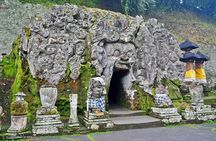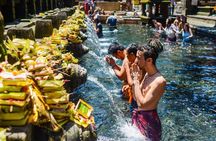
No expiration date
Easy refund
Free exchange
Easy booking
Bali Culture and Temple Tour
$65
This is an experience gift voucher. The recipient will book the experience after
they redeem the gift voucher.
Overview
This private tour offers a meaningful cultural journey to discover the authentic soul of Bali. You won’t just visit temples—you’ll explore the traditional way of Balinese life, learn about spiritual beliefs, and hear untold stories from the days of ancient Balinese kingdoms.
Your local guide will share unique insights about the difference between Western and Balinese culture, and how history, religion, and community are deeply connected here. Perfect for travelers seeking more than just sightseeing—this tour is an immersive experience into Bali’s living culture.
Your local guide will share unique insights about the difference between Western and Balinese culture, and how history, religion, and community are deeply connected here. Perfect for travelers seeking more than just sightseeing—this tour is an immersive experience into Bali’s living culture.
—
Bali Culture and Temple Tour
Best Experience Culture Guide
Pickup included
Best Experience Culture Guide
Pickup included
Tour guide
Language: English
Human tour guide
- Parking Fees
- Fuel surcharge
- Air-conditioned vehicle
- Sarung to enter the temple.
- Bottled water
- Private transportation
- Entrance tickets to all sites are not included and need to be paid directly on the spot.
- Additional pickup charge for locations outside Ubud area (cost depends on distance)
- Lunch
-
Traditional Classical Barong Dance The play tells the story of Kunti, the mother of Sadewa, who promised to give her child to the devilish Rangda. However, Kunti was unable to surrender her beloved son to the forces of evil. Of course, this refusal angered the wicked Rangda who bewitched Kunti and her guards, forcing the guards to Sadewa deep into the forest and leave him in front of Rangda’s palace. The Lord Shiva, who witnesses the helplessness of the innocent child, comes down to help Sadewa, granting the boy immortality. Essentially, the play is about how good triumphs over evil. This is generally the underlying theme in most Balinese performances, which through dance, music and drama aim to spread good moral teachings.The most popular Barong Dance at Batubulan in Gianyar, and the Denpasar suburbs. Shows are locally managed locally; dances performed by villagers, and live gamelan orchestra accompanies the full length of the show.
-
The Balinese traditional compound is basically divided into three parts on which part has different purposes. Applying the directional concept of their traditional compass, holy structures are built at the mountain at the mountain – wards of the compound such as shrines ( head ), in the middle yard are built all structures of living quarter ( body ), and at the seawards for kitchen and remaining land where they usually throw garbage away. A Balinese traditional compound is mostly enclosed either red bricks, sand stones, or odove walls covered with thatch roof made sedge grass or rice stubble. In front of the compound is the entrance gate.On both sides of the entrance walls, there are two niches as the substitution of shrines where , if the family is a bit financially better off they usually construct separate shrines, sometimes elaborate ones.
-
Puseh Batuan TempleThis 11th century temple faces a separate large communal hall, Batuan Temple, referred to locally as ‘Pura Puseh lan Pura Desa Adat Batuan’, is a focal landmark in the namesake village of Batuan, Up the five-tiered ‘candi bentar’ gate of Batuan Temple, you’ll come across various reliefs depicting mythical Balinese figures and floral themes, as well as statues depicting the Hindu trinity, Brahma, Vishnu and Shiva further inside. A series of multi-tiered thatched-roof shrines within the temple’s inner courtyard are set in a layout that is typical of all large temple complexes in Bali. The temple pavilion’s wooden beams and ceilings are heavily engraved and gold gilded.
-
Elephant CaveGoa Gajah’s name is slightly misleading, lending the impression that it’s a gigantic dwelling full of elephants. Nevertheless, Goa Gajah ‘Elephant Cave’ is an archaeological site of significant historical value that makes it a special place to visit. Goa Gajah dates back to the 11th century, built as a spiritual place for meditation. Upon reaching the base you will come across a large ‘wantilan’ meeting hall and an assortment of large old stone carvings, some restored to their former full glory. The pool, excavated in 1954, features five out of supposedly seven statues depicting Hindu angels holding vases that act as waterspouts. Various structures reveal Hindu influences dating back to the 10th century, and some relics feature elements of Buddhism dating even earlier to the 8th century. The cave is shallow; inside are three stone idols each wrapped in red, yellow and black cloths. Black soot lines the cave’s walls as result from the current-day incense burning.
-
Tegalalang Rice TerraceTegallalang Rice Terraces in Ubud is famous for its beautiful scenes of rice paddies involving the subak (traditional Balinese cooperative irrigation system), Tegallalang forms the three most splendid terraced landscapes in Ubud's shared region, with the others being in the villages of Pejeng and Campuhan. The Tegallalang rice terraces alone offers a scenic outlook that spreads down before you and away to the rice paddies on the slopes across the valley. The high roadside location is cool and breezy and it is a well-known spot for tourists to stop and take photos.
-
Tirta Empul TempleTirta Empul is an important temple complex and holy mountain spring. The complex, built circa 960 AD, is also a silent witness to the old Balinese kingdom years, particularly at the time of the Warmadewa Dynasty. Tirta Empul, meaning ‘holy water spring’ is actually the name of a water source located within the temple. The spring feeds various purification baths, pools and fish ponds surrounding the outer perimeter, which all flow to the Tukad Pakerisan River. Inside the central courtyard, referred to as ‘madya mandala’ or ‘jaba tengah’, pilgrims first approach a rectangular purification bath where a total of 13 elaborately sculpted spouts that line the edge from west to east. After solemn prayers at an altar-like shrine, they proceed to enter the crystal-clear, cold mountain water. With hands pressed together, they bow under the gushing water of the first spout, carrying on to the eleventh. The water from the last two ofthe 13 spouts is meant for purification purposes in funerary rites
How it works?
01
—
You choose from 10,000+ experience gifts
02
—
We deliver the eVoucher or the Physical box to the recipient
03
—
Recipient books the experience and creates unforgettable memories!
Bali Culture and Temple Tour
$65
This is an experience gift voucher. The recipient will book the experience after
they redeem the gift voucher.
How it works?
01
—
You choose from 10,000+ experience gifts
02
—
We deliver the eVoucher or the Physical box to the recipient
03
—
Recipient books the experience and creates unforgettable memories!




